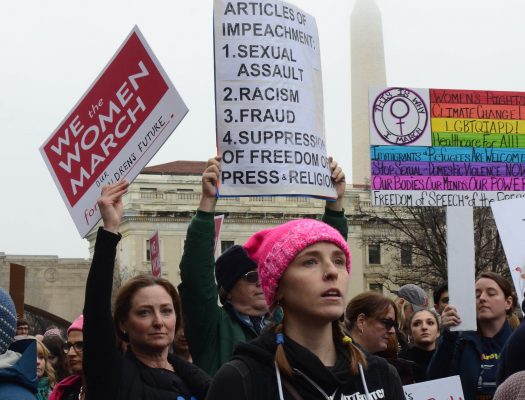The March Becomes the Movement
ERIN O’FLYNN/THE OBSERVER
Around 500,000 people attended the Women’s March on Washington in D.C. on Jan. 21. (ERIN O’FLYNN/THE OBSERVER)
February 8, 2017
“Women united will never be divided,” went one of the more memorable chants from the Women’s March on Washington. The sea of pink roared this mantra while waiting for the rally before the march to commence.
When I arrived at the march on the morning of Jan. 21, I was in awe of the mass of people gathered in D.C. In the hour that it took my friend to walk from our lodging to Independence Avenue, we passed clusters of people in knitted pink hats, and as we got closer, the clusters of people became groups of hundreds. Then we reached the giant mass of march participants.
We found ourselves at the rear of the protesters already assembled for the rally. At 9:30 am we couldn’t see the stage—we couldn’t even see the second monitor that broadcasted the rally in real time.
Unsatisfied with our positions in the crowd, we went around the block from Jefferson Drive and 4th Street SW and made our way to the right of the main stage. Our new vantage points not only gave us a clear view of the speakers, but we could also see them coming on and off the stage. Gloria Steinem, Cecile Richards and the Mothers of the Movement waved to the crowd as they walked up the stage.
Many speakers gave an anti-hate formula for proceeding past this election. The right to access safe abortions, the wage gap, rights for immigrants and anti-Islamophobia were among the topics discussed which have an effect on the lives of women.
“We know that it is right for this nation to prioritize women’s issues,” California Senator Kamala Harris said to the crowd. Women’s issues, she proclaimed, include the economy, national security, health care, education, criminal justice reform and climate change. “Because we all know the truth, if you are a woman trying to raise a family, you know that a good paying job is a woman’s issue.”
Inclusion was a prominent theme of the day—the idea that all women, no matter race, class, sexual orientation, would be represented and fought for in this movement. Fists went up and cheers erupted throughout the speeches. Each person there seemed to be boundless in their promise, determination and resolve to fight for these issues. It did not feel like a protest. It felt like a movement – it felt like a collective unit tied together by shared grievances and by shared compassion.
“This is a women’s march, and this women’s march represents the promise of feminism against the pernicious powers of state violence,” Angela Davis, activist and academic, said. “An inclusive and intersectional feminism that calls upon all of us to join the resistance to racism, to Islamophobia, to anti-Semitism, to misogyny, to capitalist exploitation.”
Davis called for a “collective resistance.” Its genesis, as I saw it, already begun to materialize in this march and its sister marches around the world.
Later in the day, TVs showed live shots of those marching across the world: Chicago, Boston, Los Angeles, New York, London, Paris, Melbourne, Nairobi, Berlin. The list goes on, in fact, to include the names of 673 cities in which marches took place with a total of nearly five million participants globally, according to the Women’s March on Washington website.
The march, or marches, did not end once the last protester went home. The leaders of the march are continuing to fight for women and planning what comes next. On its website, leaders of the march are posting “10 actions in 100” days to facilitate the movement.
The march is over. The signs have been cleaned up. The participants went home. But people are still chanting. People are still fighting. And people are still taking action and making their voices heard in this movement. What comes next in the movement is a fight for what is right and just and fair.











Willie Danson • Apr 24, 2017 at 11:02 pm
this is iconic